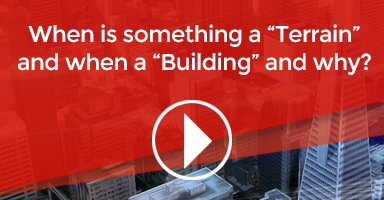Terrain
(In Dutch)
What is meant by Terrain?
The Tygron Platform uses the term terrain to describe the composition of the surface, subsurface and their elevation in a project. This does not include any features built upon it, which are known as constructions.
Surface
The Tygron Platform differentiates between various types of terrain. Each terrain type has its own predefined attributes that may have an effect on various indicators and overlays, such as green, livability and rainfall flooding. A description of all available terrain types is listed in the table below.
| EN | NL | Description |
|---|---|---|
| Concrete | Beton | Commonly found in urban and industrial areas. |
| Levee | Dijk | A construction usually built between a water body and low-lying land (polder) offering protection from flooding. |
| Dunes | Duinen | A naturally occurring landscape feature forming the division between the beach and the hinterland. |
| Breakwater | Golfbreker | A construction designed to protect the coastline from wave action. |
| Grassland | Grasland | Area dominated by grass vegetation. |
| Open land | Open land | The default terrain type for land surface. If an empty world is generated, this type will cover the entire map. |
| Waterloop | Waterway | A waterway which is often part of a 'managed' water system |
| Watervlakte | Waterbody | A water body which is often not part of a 'managed' water system. |
| Sand | Zand | Area largely consisting of sandy sediment. |
Each surface terrain type contains the following attributes:
| Attribute | Unit | Description |
|---|---|---|
| BUILDABLE | Indication whether a terrain can be built upon or not. | |
| GROUND_INFILTRATION_MD | m/d | Infiltration capacity of the surface soil into the subsoil. This attribute is used in calculations of the Rainfall Overlay. |
| HEAT_EFFECT | °C | Measure of impact on the heat stress overlay. |
| LIVABILITY_EFFECT | Measure of impact on the livability overlay. | |
| POLDER_WATER | Value 1: it is possible to build a construction on top or near this terrain type. Value 0: the terrain is not buildable. | |
| SAFETY | ||
| TERRAIN_MIX | ||
| TEXTURE_TYPE | ||
| WATER | Most constructions can only be built upon land, hence cannot occur on this terrain type. Water terrains play an important part in the calculations by the Water Module. Three types are distinguised; 1: waterways, 2: water surfaces and 3: sea. This distinguishing value is used for several tools and algorithms. | |
| WATER_DEPTH_M | m | Whenever a new project is created by going through the new project wizard, the water terrains will have a value for the maximum depth. Respectively water: 2m and River water: 3m. |
| WATER_EVAPORATION_FACTOR | Multiplication factor of the reference evaporation (see Rainfall Overlay). | |
| WATER_MANNING | s/m1/3 | Measure of surface roughness, used in the surface flow computation of the Water Module. |
Subsurface
The Tygron Platform differentiates between various types of subsurface terrain types. Subsurface terrain data was originally acquired from FGR, however, as of version 2019.0.0 this has become BRO. The Subsurface Overlay shows the different soil types composing the subsurface, each having distinctive predefined attributes. The table below shows a division into the different terrain categories, which, in turn, have their own subdivisions into multiple subsurface soil types.
| EN | NL | Description |
|---|---|---|
| Gravel | Grind | |
| Clay | Klei | |
| Chalk | Krijt | |
| Loam | Leem | |
| Loess | Löss | |
| Unknown | Onbekend | Default, if no subsurface data is available. |
| Silt | Silt | |
| Peat | Veen | |
| Sand | Zand | |
| Marine clay | Zeeklei |
Each subsurface terrain type contains the following attributes:
| Attribute | Unit | Description |
|---|---|---|
| ANGLE_OF_REPOSE | angle (0-90°) | The different subsurface types each attain a value for the maximum slope (Dutch: talud). This value is used for creating the water edge steepness and indirect for the water depth. |
| BUILDABLE | boolean | Attribute determining whether or not the subsurface tolerates the construction of new buildings. |
| GROUND_INFILTRATION_MD | m/d | Infiltration capacity of the surface soil into the subsoil. This attribute is used in calculations of the Water Overlay. |
| PEAT_FRACTION | fraction | The fraction of the subsurface which will be considered to be peat by the Subsidence Overlay. |
| TOPLAYER_THICKNESS | m | The depth of the clay soil layer, as considered by the Subsidence Overlay |
| WATER_STORAGE_PERCENTAGE | fraction | Fraction of the volume of water that can be stored per volume of soil, usually expressed as the saturated minus residual water-content properties of the soil. |
Elevation
From the Terrain tab, the user can choose to manually change the current surface elevation model in the project, or to import one in the form of a GeoTIFF file. More information regarding the elevation model can be found on the terrain height page.
